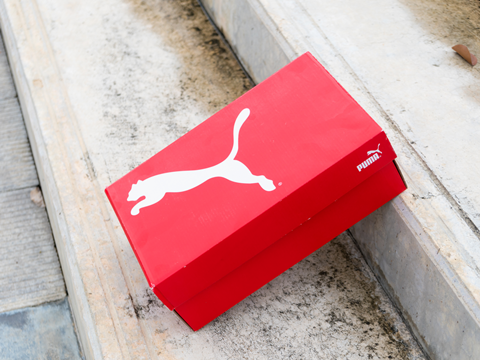
In its 2024 Sustainability Report, PUMA claims to have achieved 99.5% paper packaging, derived 99% of its paper and cardboard from recycled or FSC-certified sources, sold zero plastic shopping bags in-store, and eliminated single-use plastics from its global offices.
As a founding member of The Fashion Pact and a partner of Canopy’s Pack4Good initiative, PUMA aspires to achieve 100% recycled and/or FSC-certified packaging, replace avoidable plastics where technically and economically feasible, and ensure the rest is made from 100% recycled content by 2030.
So far, the company claims to have phased single-use plastic shopping bags out of its owned or operated PUMA stores as of January 2023 – a move thought to have reduced its plastics consumption by ‘several hundred tons’ every year and aligned with its 10FOR25 targets. Its consumer-facing polyethylene bags have now been replaced with either durable multi-use bags or FSC-certified paper bags.
As of last year, it claims to have utilized 99.5% paper packaging last year, with 99% of its paper and cardboard believed to be recycled or FSC-certified.
All clothing hangers used in-store are now made from recycled polymers or replaced with FSC-certified wooden alternatives, the company says, while 100% of its global offices also reported a total avoidance of single-use plastic coffee cups, lids, stirring sticks, straws, and cutlery in 2024.
Outer carton boxes, shoe boxes, and poly bags used in transit are listed among the ‘most substantial portions’ of PUMA’s waste. It indicates that ‘most’ of its polyethylene B2B transit packaging contains 100% recycled content, with its thickness reduced to lower its weight.
Despite previously trialling transit bags made from paper in the USA, their decreased durability and higher costs have prevented a full-scale transition so far. However, PUMA plans to keep paper as a ‘viable alternative’ for shipping suitable apparel and accessories while working to improve its performance and price.
Regarding greenhouse gas emissions, PUMA reports that only 0.16% (672.3216 tonnes of CO2 equivalent) of its total contributions originated from plastic packaging, and 2% (8404.02 tonnes of CO2 equivalent) stemmed from paper packaging.
It also cites estimates that its subsidiary brand, stichd, can attribute 3.5% (40922.525 tonnes of CO2 equivalent) of its emissions to plastic packaging and 3.6% (42091.74 tonnes of CO2 equivalent) to paper.
Meanwhile, PUMA allocates 0.1% (9,062 GJ) of its energy consumption to plastic packaging and 1.6% (202,496 GJ) to paper, which stichd estimates 4.5% (32,785 GJ) for plastic and 9% (66,225 GJ) for paper.
Plastic packaging is thought to constitute 0.008% (3,384m3) of PUMA’s water consumption and 0.1% (8,901m3) of stichd’s. Its paper equivalent is linked to 0.1% (58,003m3) of PUMA’s water consumption and 0.1% (8,180m3) of stichd’s.
Additionally, the land use impact of each brand’s raw materials was considered. PUMA’s plastic and paper packaging utilize a respective 338 hectares and 5,800 hectares of land, while stichd is thought to use 890 hectares for plastic packaging and 992 for paper – making the latter its second most land-intensive application.
In future, PUMA plans to work with its industry peers to develop sorting and recycling solutions, factoring in Extended Producer Responsibility (EPR) schemes.
The news comes as several other big brands are missing and revising their sustainable packaging targets for 2025. Companies like Unilever and Colgate-Palmolive blame the industry-wide struggle to recycle flexible plastics, while The Coca-Cola Company points to inefficient regulation and consumer behaviours. Walmart also faces pressure from right-wing shareholders to turn its focus away from sustainability initiatives.
For more detailed insight into the progress of the six top FMCG signatories of the Ellen MacArthur Foundation’s Global Commitment, including Mars, Nestlé, and PepsiCo, take a look at our recent report.
If you liked this story, you might also enjoy:
The ultimate guide to the Packaging and Packaging Waste Regulation in 2025
How are the top brands progressing on packaging sustainability?
Everything you need to know about global packaging sustainability regulation in 2025
The key to increasing the use of reusable packaging in supermarkets


















No comments yet